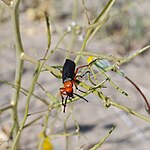
Juan Bautista de Anza Bezerra Nieto was an expeditionary leader, military officer, and politician primarily in California and New Mexico under the Spanish Empire. He is credited as one of the founding fathers of Spanish California and served as an official within New Spain as Governor of the province of New Mexico.
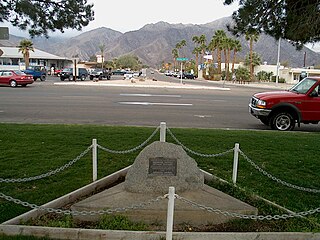
Borrego Springs is a census-designated place (CDP) in northeastern San Diego County, California. The population was 4,031 at the 2020 census. Borrego Springs is surrounded by Anza-Borrego Desert State Park.

The Sonoran Desert is a hot desert and ecoregion in North America that covers the northwestern Mexican states of Sonora, Baja California, and Baja California Sur, as well as part of the Southwestern United States. It is the hottest desert in both Mexico and the United States. It has an area of 260,000 square kilometers (100,000 sq mi).
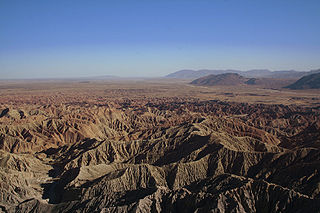
Anza-Borrego Desert State Park is a California State Park located within the Colorado Desert of Southern California, United States. The park takes its name from 18th century Spanish explorer Juan Bautista de Anza and borrego, a Spanish word for sheep. With 585,930 acres (237,120 ha) that includes one-fifth of San Diego County, it is the largest state park in California and the third largest state park nationally.
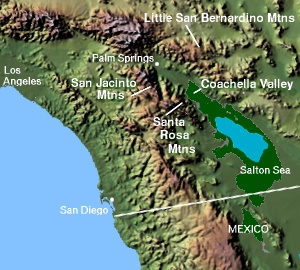
The Santa Rosa Mountains are a short mountain range in the Peninsular Ranges system, located east of the Los Angeles Basin and northeast of the San Diego metropolitan area of southern California, in the southwestern United States.

Colorado Desert is a part of the larger Sonoran Desert located in California, United States, and Baja California, Mexico. It encompasses approximately 7 million acres, including the heavily irrigated Coachella, Imperial and Mexicali valleys. It is home to many unique flora and fauna.
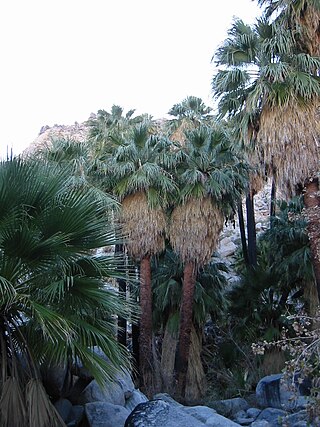
Washingtonia filifera, the desert fan palm, California fan palm, or California palm, is a flowering plant in the palm family Arecaceae, native to the far southwestern United States and Baja California, Mexico. Growing to 15–20 m (49–66 ft) tall by 3–6 m (10–20 ft) broad, it is an evergreen monocot with a tree-like growth habit. It has a sturdy, columnar trunk and waxy, fan-shaped (palmate) leaves.

Blister beetles are beetles of the family Meloidae, so called for their defensive secretion of a blistering agent, cantharidin. About 7,500 species are known worldwide. Many are conspicuous and some are aposematically colored, announcing their toxicity to would-be predators.

Thomas Long "Pegleg" Smith was a mountain man who, serving as a guide for many early expeditions into the American Southwest, helped explore parts of present-day New Mexico. He is also known as a fur trapper, prospector, and horse thief. Peg Leg Smith Monument, is a historical site in Anza-Borrego Desert State Park, California. Peg Leg Smith Monument site is a California Historical Landmark No. 452, listed on October 11 ,1960.

The Sawtooth Mountains Wilderness is a federal wilderness area of 32,136 acres (130.0 km2) in the Sawtooth Mountains in eastern San Diego County, California. It is located in the Colorado Desert, 35 miles (56 km) south of Borrego Springs, near Anza Borrego Desert State Park.

The Santa Rosa Wilderness is a 72,259-acre (292.42 km2) wilderness area in Southern California, in the Santa Rosa Mountains of Riverside and San Diego counties, California. It is in the Colorado Desert section of the Sonoran Desert, above the Coachella Valley and Lower Colorado River Valley regions in a Peninsular Range, between La Quinta to the north and Anza Borrego Desert State Park to the south. The United States Congress established the wilderness in 1984 with the passage of the California Wilderness Act, managed by both the US Forest Service and the Bureau of Land Management. In 2009, the Omnibus Public Land Management Act was signed into law which added more than 2,000 acres (8.1 km2). Most of the Santa Rosa Wilderness is within the Santa Rosa and San Jacinto Mountains National Monument.
The Regions of the San Diego metropolitan area and San Diego County, as they cover the same area are:
Earthquake Valley is a desert valley east of Julian, California, which contains parts of Anza-Borrego Desert State Park. It is the location of the Shelter Valley Ranchos subdivision, which is also known as the unincorporated community of Shelter Valley. The official USGS place name for the geologic feature in which Shelter Valley is situated is "Earthquake Valley", and the 1959 USGS Topographic map makes no reference to Shelter Valley. The name of the unincorporated community Shelter Valley is typically used both locally and by the media to refer generally to the geological feature of Earthquake Valley, and it is common for both names to be referenced in publications after the 1962 establishment of the subdivision. Author, poet, artist and primitivist Marshal South lived in and wrote about the general area, in a series of articles for Desert Magazine between 1941 and 1948. A number of notable trails pass through the valley, including the Pacific Crest Trail, the California Riding and Hiking Trail, and the Southern Emigrant Trail.
Shelter Valley is a community in San Diego County in the U.S. state of California. The town is located along County Route S2, two miles (3.2 km) south of its intersection with State Route 78 and 12 miles (19 km) east of Julian. It lies within the boundaries of Anza-Borrego Desert State Park and the geologic feature known as Earthquake Valley. The Pacific Crest Trail passes along the northern boundary of the community.

Lytta is a genus of blister beetles in the family Meloidae. There are about 70 described species in North America, and over 100 species worldwide.

Lost Palms Oasis Trail is a 7.2-mile (11.6 km) day-hike trail located in the southernmost part of Joshua Tree National Park. The trail is generally completed in a loop. Known for the beautiful palm trees from which the trail gets its name, this hike is also known for its great bouldering, pools of water, and the ever-elusive "Victory Palms". Deemed by the National Park Service as a day-use-only area, this trail is also home to bighorn sheep who use the pools as their main source of water.

San Gregorio campsite at the Borrego Sink in the Borrego Valley, Borrego Springs, California, in San Diego County, is a California Historical Landmark No. 673 listed on February 16, 1959. The San Gregorio campsite was a desert camp for the Spanish Commander Juan Bautista de Anza's expedition of 1775 and 1776. The expedition passed through the Imperial Valley then through the Colorado Desert, now Anza-Borrego Desert State Park. The expedition's goal was to start Spanish missions in California and presidio forts through Las Californias to San Francisco Bay. The expedition route is now the Juan Bautista de Anza National Historic Trail.

El Vado campsite in the Borrego Valley, Borrego Springs, California, in San Diego County, is a California Historical Landmark No. 634 listed on March 3, 1958. The El Vado campsite was a desert camp for the Spanish Commander Juan Bautista de Anza and Father Francisco Garcés expedition of 1775 and 1776. The expedition camped for three days and two nights from December 20 to 22, 1775. At the campsite the expedition rested and watered its stock of mules, cattle, and horses.

Santa Catarina campsite in the Borrego Valley, Borrego Springs, California, in San Diego County, is a California Historical Landmark No. 785 listed on March 3, 1958. The Santa Catarina campsite was a desert camp for the Spanish Commander Juan Bautista de Anza and Father Francisco Garcés expedition of 1775 and 1776. At the campsite the expedition rested and watered its stock of mules, cattle, and horses on March 14, 1774.


